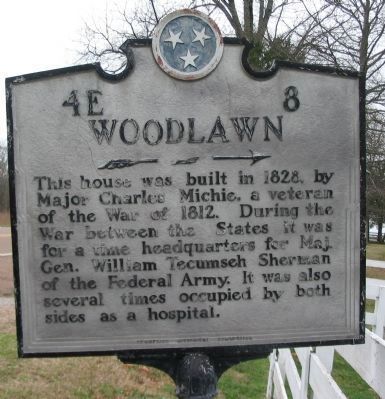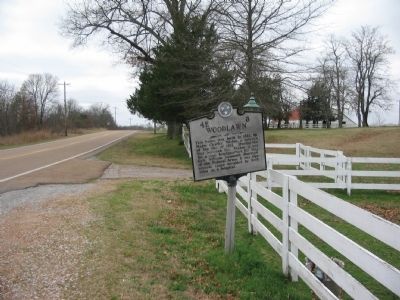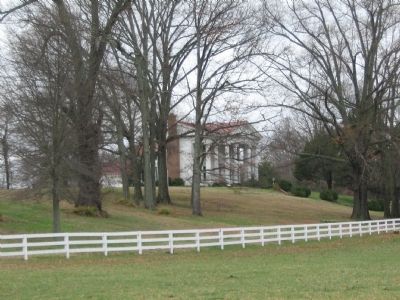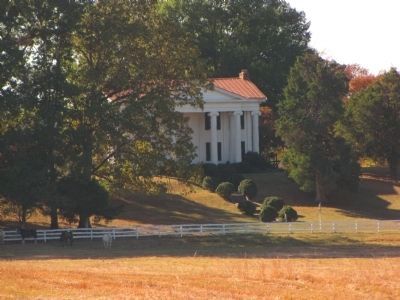Near LaGrange in Fayette County, Tennessee — The American South (East South Central)
Woodlawn
Inscription.
This house was built in 1828 by Major Charles Michie, a veteran of the War of 1812. During the War between the States it was for a time headquarters for Maj. Gen. William Tecumseh Sherman of the Federal Army. It was also several times occupied by both sides as a hospital.
Erected by Tennessee Historical Commission. (Marker Number 4E 8.)
Topics and series. This historical marker is listed in these topic lists: Science & Medicine • Settlements & Settlers • War of 1812 • War, US Civil. In addition, it is included in the Tennessee Historical Commission series list. A significant historical year for this entry is 1828.
Location. 35° 2.77′ N, 89° 13.164′ W. Marker is near LaGrange, Tennessee, in Fayette County. Marker is on 3rd Street (State Highway 57), on the right when traveling west. Touch for map. Marker is in this post office area: Moscow TN 38057, United States of America. Touch for directions.
Other nearby markers. At least 8 other markers are within 2 miles of this marker, measured as the crow flies. The Bird Dog & Field Trial Capital of the World (approx. ¾ mile away); The Gloster - Anderson Graveyard (approx. 0.9 miles away); Immanuel Church (approx. 1.3 miles away); LaGrange (approx. 1.4 miles away); Grierson's Raid (approx. 1.4 miles away); La Grange (approx. 1.4 miles away); The Bird Dog Foundation, Inc. (approx. 1½ miles away); Home of Lucy Holcombe Pickens (approx. 1½ miles away). Touch for a list and map of all markers in LaGrange.
Also see . . . LaGrange, Tennessee. Wikipedia entry (Submitted on January 14, 2024, by Larry Gertner of New York, New York.)
Additional commentary.
1. Woodlawn
From Tennessee: A Guide to the State from the Federal Writer's Project (WPA Guide):
Left from La Grange on State 57, 1.3 m. to Woodlawn, which stands on a wide double terrace that was handsomely landscaped in 1859. The house was built in 1828 by Maj. Charles Mitchie, who inspected every bit of wood and work with great care. The large two-story structure, of rather severe Classical Revival design, has a roof that extends forward over an Ionic portico, two-thirds of which is projected forward and capped with a pediment. There is a small balcony over the pilastered entrance.
During the War between the States the house became the West Tennessee headquarters of General Sherman and several times sheltered wounded men. In 1875 it was bought by Dr. John Junius Pulliam who restored it. Note To Editor only visible by Contributor and editor
— Submitted May 24, 2009, by Craig Swain of Leesburg, Virginia.
Credits. This page was last revised on January 14, 2024. It was originally submitted on May 24, 2009, by Craig Swain of Leesburg, Virginia. This page has been viewed 2,168 times since then and 49 times this year. Photos: 1, 2, 3. submitted on May 24, 2009, by Craig Swain of Leesburg, Virginia. 4. submitted on October 26, 2010, by Lee Hattabaugh of Capshaw, Alabama.



